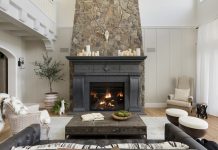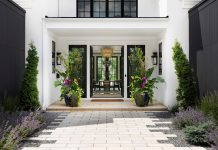
Courtesy of Bonnie Rubinstein
Some people never discover or pursue their passions in this world, but Bonnie Rubinstein isn’t one of them. Years after working on the planning side of design and landscaping, Rubinstein decided to pursue her passion for working with glass as an art form.
Her art ranges in size, shape, look, and purpose. She creates everything from bowls, platters, and tabletop sculptures to light fixtures, sinks, and landscape sculptures. While she mostly works with fused glass, she also incorporates steel in some of her wall pieces and uses metal for her aerial art.
We were intrigued to know more about Rubinstein’s passion for fused glass and how her creative process works. Here’s what we learned.
What inspired you to become an artist?

Courtesy of Bonnie Rubinstein Studio
I think I was always interested in design and how things are put together both functionally and beautifully. I went from just being a landscape architect and urban designer to a jewelry designer, and I manufactured hand-crafted architectural jewelry in the 1980s.
Then, I started really recognizing the impact all of us and businesses were having on the environment. I do have an environmental science degree in addition to an advanced degree in landscape architecture and urban design, so I started consulting with businesses on sustainability. After doing that for many years, I really missed hands-on design and started learning more about glass. That’s always been a passion of mine.
Why did you choose to work in glass?
As a child, I loved looking at colored glass items. I was mesmerized by the color and the light playing together. Around 15 years ago, I started really studying glass more avidly and found fused glass as a medium that I could really relate to because I could take the design and put them into the glass, and they’d retain their shape and form. The design would be maintained even at 1,400 degrees Fahrenheit.
Fused glass differs from glassblowing, which goes to a much higher temperature and the design becomes much more molten. You can’t easily have a theme in blown glass the way you can have a theme in fused glass. If you look at some of my pieces, you can recognize a strategic element I placed there for a reason. You can see different elements clearly, and that’s what I loved about fused glass. I could come up with a concept, make it happen in the glass, and it would maintain. You’d have a piece of art that’s not on canvas on your wall but it’s on glass. It’s a new way to use the medium of glass.
It’s much more vibrant and much more challenging than any medium I’ve ever worked in, and I’ve worked in a lot of mediums. Glass does require patience because it’s also a fragile medium. If you don’t study it and understand it, you won’t have a successful piece in the end—you’ll have a shattered piece. There’s a lot of science that goes into understanding glass.
Can you explain the process of making one of your bowls?

One of Bonnie Rubinstein’s fused glass bowls. Courtesy of Bonnie Rubinstein Studio
I come up with the concept that I want to transfer into the glass. I start with a clear piece of fusible glass.
- I start cutting out the shape of colored glass that I will lay onto the clear glass.
- I start thinking about the way I want to layer the colors together so that when they fuse together, they end up making another color.
- I also put a lot of visual textures in my glass. (3D bubbles, crush glass into dust)
- Then I put it in the kiln and slowly raise it up to 1,420 degrees Fahrenheit. Then slowly cool it down. That takes about 24 hours.
- Then I take that piece out of the kiln and start layering more glass on top of that for more texture or more visual interest.
- I put it back in the kiln to heat up and cool down again for another 24 hours.
- I put that flat piece into a bowl-shaped stainless steel or clay mold.
- I put the piece back in the kiln, heat to 1,200 degrees Fahrenheit, then slowly cool it down over another 24-hour cycle. A glass bowl could take me 2-3 weeks to make.
Glass has a very unique personality and if you understand the personality of the glass based on the thickness of the glass, you can program that into the computer. That’s the only way you’ll have a successful piece. Or else you’ll have a piece at the end that’s shattered. It’s very sensitive. Once it’s done, it’s beautiful and durable. But you have to use the schedule that’s right for that glass to get it to that point.
What is your favorite part about glass art?
Seeing the results and seeing how the light plays with colors—seeing the end result on a wall or on a ceiling is so powerful. I get excited walking into a space seeing the art I created, even though I’ve been there a dozen times.
That’s part of it. Then the other part of it is how the client reacts to the work, and how they feel about their space once the art is in it. I just installed a chandelier for a client in Golden Valley, and she was jumping up and down she was so excited. Wow! That’s so fulfilling to me that every time she goes into her dining room, she’s going to feel this happiness.
What inspired you to start your own business?

Courtesy of Bonnie Rubinstein Studio
I’m very entrepreneurial anyway, but there wasn’t anyone doing it at the time I started this. I don’t even know if there are that many people doing it now. Because I was so inspired by the medium, I realized if I want to work in the medium, I’ve got to get the word out there about it. The business allows me to be creative, so I needed to start the business so the creativity could roll outward.
I was excited about the medium. I still am. When I talk to people about it and I show them some of my work, and I talk about how we could work together, they get excited. That’s the best. I can’t understate the beauty of colored glass with light and what it does. I am so in love with it. It’s hard to even put into words why I do it.
To purchase one of Rubinstein’s art pieces or work with her on a custom design, please contact her via her website.




















